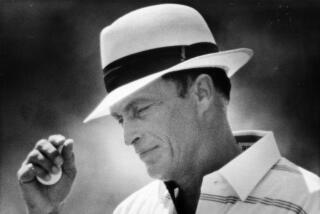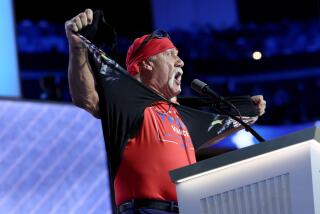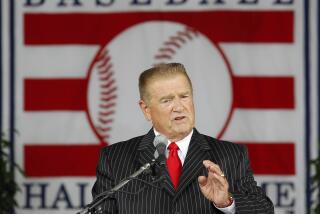Ben Hogan Dies, but Not the Mystique
Ben Hogan was more than an athlete to me.
Hogan was mythic. Hogan was my idol. âCharismaâ doesnât begin to describe the hold Hogan had on our imaginations, on the golfing publicâs.
We held Hogan, who died Friday at the age of 84, to a higher standard than we did the rest of the sports world.
To us, he was like the cowboy hero of a thousand Saturday afternoon serials. He could do no wrong, could never let you down.
The golf game is awash with Hogan stories. My favorite is the time Hogan was playing Riviera. Now, Hogan never asked a caddie anything except maybe what time it was. But after his drive on 15, he looked at the ball, the green in the distance, and turned to his caddie and said, âWhatâs the shot?â And the caddie squinted at the green, threw grass in the air, and said, âMr. Hogan, itâs 146-147 yards.â Hogan scowled at him. âMake up your mind!â he ordered.
How good was he? The latest book about him (âHoganâ by Curt Sampson) notes that he teed it up in 292 lifetime tournaments and he finished in the top 10 241 times--and in the top three 139 times! Are you paying attention, Tiger?
Even his losses were epic. Jack Fleck beat him in a playoff for the U.S. Open in 1955, but Fleck was never the man who won the Open that year; he was the man who deprived Ben Hogan of his fifth U.S. Open championship, who committed an offense against nature. He might have come to wish he hadnât.
Hogan was quite simply--with apologies to Jack Nicklaus, Arnold Palmer and even Tiger Woods--the best striker of the ball who ever played.
It didnât come naturally to him; he mastered it, subdued it, as he did every challenge in his life. Hogan was grim, stubborn, stable and relentless. He practiced till his hands bled. He didnât worry about being long off the tee, although he was. He hit the ball where he wanted to, not where it wanted to. Where it left the best next shot.
I worshiped him, revered him. My finest hour in the game came once in a practice round Palmer was enduring at Rancho. On one hole, he hit the ball dead left, into a buried lie underneath beer cans, pine cones, fallen branches, even squirrels. Arnold spotted me, hitched up his pants and growled, âOK, wise guy, what would your idol Hogan do here?â I smiled. âHogan wouldnât be here,â I told him. Arnold laughed. Hogan had all the trouble shots. He just didnât need them much.
I never could understand why Ben didnât call the cops when I came into view in his life. I was bad news to him. It began when I did principal work on the cover story we ran on him in Time magazine in 1949. I had followed him for five days. I grew to respect him more than anyone I had ever interviewed. The night the story was closing, we had a chart illustrating Hoganâs âaverageâ distance with a driver, a four-wood, seven-iron, etc. Hogan frowned. âThereâs no average distance!â he exclaimed. âIt depends on the time of day, the temperature, whether itâs cloudy or foggy, the lie, the composition of the grass!â
âBen!â I screamed. âTheyâre holding the presses at Donnelly in Chicago at $40,000 a minute!â No matter. We had to get it right or no Hogan OK.
The point is, after the Time cover appeared, Hogan got hit by that bus on his way home in Texas, giving rise to the âTime cover jinx.â (Sugar Ray Robinson was later to lose his first fight after appearing on our cover, solidifying the hoodoo.)
Next, I was sitting with Ben in the locker room at the Olympic Club in San Francisco just after he had apparently won the â55 Open when over the transom above our heads began to trickle announcements of birdies by someone named Jack Fleck. A black day. Fleck tied him and was to win the playoff the next day. I was beginning to feel around Ben like that guy in âLiâl Abnerâ who goes around with a cloud over his head.
I wrote about him extensively over the years, all aspects of the Hogan mystique. His name, for instance.
âThroughout the history of civilization, there have been syllables of terror handed down from generation to generation. âGeronimo,â for example, could be counted on to empty one fort after another in the old West. âAttilaâ would strike as much naked fear as the plague. In the littler world of golf, âHoganâ elicited much the same effect. Nothing could paralyze a field of golfers as much as this whispered collection of syllables. Strong men bogeyed when they heard this dreaded name. Sam Snead once said the only thing he feared on a golf course was lightning--and Ben Hogan.â
When he couldnât putt any more (he was in his 50s), I wrote about that sadly.
âI never saw any of manâs baser acts of inhumanity to man. I never saw screaming âwitchesâ burned at the stake, Christians tossed to starving lions, maidens pushed over the edge of active volcanoes. I never even saw a man going to the electric chair. But until I do, watching Ben Hogan walk up to a five-foot putt is my idea of cruel and inhuman punishment, only a Hitler would enjoy. You feel like saying, âGo home to your wife and kiddies and donât look upon this terrible thing!â â
What did he do to engender these kinds of lyrical outbursts? Well in 1953, one of his last productive years on the greens and fairways (limited after his bus accident because he lacked a vena cava and had to stand on his head in the morning to get the blood flowing), he teed it up in six tournaments. And won five of them. And what five! The Masters, the U.S. Open, the British Open, the Colonial and Pan-American Open. Itâs as close as anybody has ever come to the modern Grand Slam. And Hogan didnât tee it up in the PGA because it was match play in those days and you had to walk 36 holes the last two days. His legs couldnât.
In 1956 he almost won his fifth Open again and inspired a rival, Mike Souchak, to blurt one day, âBen Hogan just knows something about hitting a golf ball the rest of us donât!â
In 1960, at the age of 48, he again could have won his fifth Open. He hit 34 consecutive greens on the last day, all 18 in the morning. He later told me he really hit the 17th in the afternoon but the ball had so much backspin it trickled back into the water. âI had to put the ball close âcause I couldnât make any putt over six feet and I fine-tuned it too much.â
What kind of man was he? Well, they said he was cold, aloof and a loner. A boy whose father shot and killed himself in front of his family when the boy was 9 years old is not apt to be a cutup. He kept the world at bay. But he could be fun-loving, a wonderful dinner companion to share a pre-meal martini with. Hogan didnât care whether you liked him or not, just whether you respected him.
Hogan played micrometer golf. He was a man of uncompromising integrity. He was married to the same woman, the marvelous Valerie, for 62 years. It was a great love story. Valerie lived because Hogan threw himself in front of her in that bus accident in 1949. They took care of each other.
Some years ago, Tom Laughlin wanted to do a new Hogan picture and said Ben wanted me to do it. I was thrilled. I spent a magical week with the Hogans and the Laughlins in Palm Springs. But I couldnât make the cut. I couldnât lick the script.
After all, it was Hogan, wasnât it? When someone said he wanted âwarts and all,â I said, âWhat warts?â
* HOGAN DEAD AT 84
Golfâs most intense competitor made one of the great comebacks in sports history. C1
More to Read
Go beyond the scoreboard
Get the latest on L.A.'s teams in the daily Sports Report newsletter.
You may occasionally receive promotional content from the Los Angeles Times.










